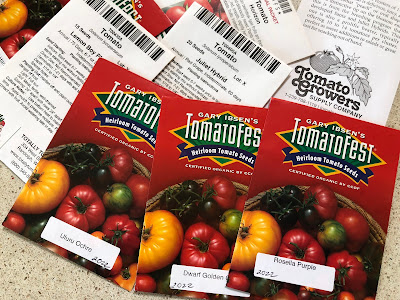
Stay warm inside and plant seeds

|
|
Dwarf varieties are among my tomato seed
purchases this year. (Photo: Kathy Morrison)
|
When it's so cold outdoors this week, it's nice to think of warmer days and summer vegetables.
There's still plenty of time to start seeds for tomatoes and other summer favorites. For a little extra help, check out an online Zoom class this weekend, presented by the Solano County master gardeners.
"Starting Seedlings for Summer, Even When It's Cold Outside" will be hosted by master gardener Alex Russell, 10 a.m. to 11 a.m. Saturday, Feb. 26. The Zoom link is here .
Last year I started all my tomatoes in late January and early February. Three weeks later, several had collapsed from inattention (I had a busy winter!) and I had to start them again -- what a waste of seeds and time. With a trip planned in the middle of the month this year, I decided to delay my seed-starting until after I returned.
The tomatoes include my favorites, Juliet, Big Beef and Lemon Boy, while this year's experiments include some of the new dwarf heirloom tomato varieties developed by the Dwarf Tomato Project and sold on the TomatoFest online store. The link will take you to a detailed description of the project, which started in 2005. For the seed listings, go here.
The distinction between dwarf tomatoes and compact determinate ones is important: The flavor apparently is better, and "these dwarf types are very distinctive in having a thick central stem, stout compact growth, and dark green, crinkly looking (so-called rugose) foliage." They top out at 3 to 4 feet in height, apparently.
This project has produced 30 varieties of open-source seeds. Many gardeners have limited space for tomatoes, so I'll be interested to see how these grow out in a Sacramento summer. I bought seeds for 4 varieties:
-- Uluru Ochre, 65 days, a 6- to 12-ounce "uniquely colored" orange-black tomato (SF Giants colors!). Indeterminate.
-- Dwarf Hannah's Prize, 75 days, 6- to 12-ounce, red with some light striping.
-- Dwarf Golden Gypsy, 75 days, 8- to 18-ounce, yellow-gold. Indeterminate.
-- Rosella Purple-Dwarf, 78 days, 6- to 12-ounce purple-black (similar to Cherokee Purple). Indeterminate.
Stay tuned this year for progress reports on these varieties.
Comments
0 comments have been posted.Sacramento Digs Gardening to your inbox.
Food in My Back Yard Series
April 22: Should you stock up on fertilizer? (Yes!)
April 15: Grow culinary herbs in containers
April 8: When to plant summer vegetables
April 1: Don't be fooled by these garden myths
March 25: Fertilizer tips: How to 'feed' your vegetables for healthy growth
March 18: Time to give vegetable seedlings some more space
March 11: Ways to win the fight against weeds
March 4: Potatoes from the garden
Feb. 25: Plant a fruit tree now -- for later
Feb. 18: How to squeeze more food into less space
Feb. 11: When to plant? Consider staggering your transplants
Feb. 4: Starting in seed starting
Sites We Like
Garden Checklist for week of April 27
Once the clouds clear, get to work. Spring growth is in high gear.
* Set out tomato, pepper and eggplant transplants.
* From seed, plant beans, beets, cantaloupes, carrots, corn, cucumbers, melons, pumpkins, radishes and squash. Plant onion sets.
* In the flower garden, plant seeds for asters, cosmos, celosia, marigolds, salvia, sunflowers and zinnias. Transplant petunias, zinnias, geraniums and other summer bloomers.
* Plant perennials and dahlia tubers for summer bloom. Late April is about the last chance to plant summer bulbs, such as gladiolus and tuberous begonias.
* Transplant lettuce and cabbage seedlings.
* Weed, weed, weed! Don’t let unwanted plants go to seed.
* April is the last chance to plant citrus trees such as dwarf orange, lemon and kumquat. These trees also look good in landscaping and provide fresh fruit in winter.
* Feed citrus trees with a low dose of balanced fertilizer (such as 10-10-10) during bloom to help set fruit. Keep an eye out for ants.
* Apply slow-release fertilizer to the lawn.
* Thoroughly clean debris from the bottom of outdoor ponds or fountains.
* Start thinning fruit that's formed on apple and stone fruit trees -- you'll get larger fruit at harvest (and avoid limb breakage) if some is thinned now. The UC recommendation is to thin fruit when it is about 3/4 of an inch in diameter. Peaches and nectarines should be thinned to about 6 inches apart; smaller fruit such as plums and pluots can be about 4 inches apart. Apricots can be left at 3 inches apart. Apples and pears should be thinned to one fruit per cluster of flowers, 6 to 8 inches apart.
* Azaleas and camellias looking a little yellow? If leaves are turning yellow between the veins, give them a boost with chelated iron.
* Trim dead flowers but not leaves from spring-flowering bulbs such as daffodils and tulips. Those leaves gather energy to create next year's flowers. Also, give the bulbs a fertilizer boost after bloom.
* Pinch chrysanthemums back to 12 inches for fall flowers. Cut old stems to the ground.
* Mulch around plants to conserve moisture and control weeds.